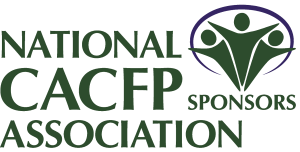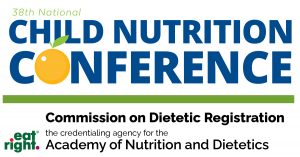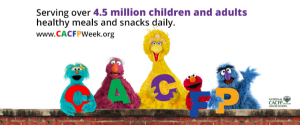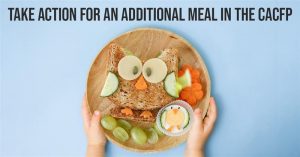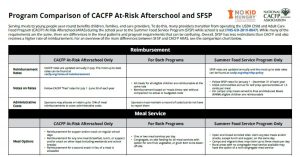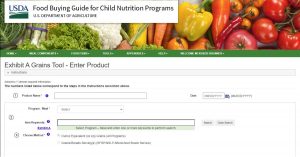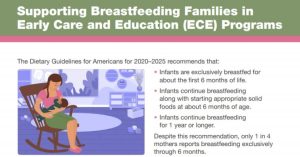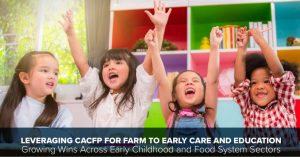Check out these virtual events coming up this month at NCA!
Read MoreCan a family style meal be reimbursed if a child does not serve themself all of the food components offered?
Read MoreWe’re thrilled to inform you that the 2024 National Child Nutrition Conference offers an excellent opportunity for you to earn Continuing Professional Education Units (CPEUs) while immersing yourself in a world of learning and networking.
Read MoreThe USDA recently released a Final Rule that better aligns meal patterns in the CACFP, SFSP, and School Meals with the Dietary Guidelines for Americans.
Read MoreThe National CACFP Sponsors Association (NCA) is pleased to present Blake Stanford with the Lifetime Achievement Award for his outstanding vision, dedication, and commitment to the advancement of the Child and Adult Care Food Program (CACFP) community.
Read MoreWhat can you do outside of meal service to prepare children for family style dining?
Read MoreCheck out these virtual events coming up this month at NCA!
Read MoreWe’re thrilled to inform you that the 2024 National Child Nutrition Conference offers an excellent opportunity for you to earn Continuing Professional Education Units (CPEUs) while immersing yourself in a world of learning and networking.
Read MoreThe National CACFP Sponsors Association is excited to introduce the newest group of scholarship winners for the 2024 National Child Nutrition Conference!
Read MoreCheck out these virtual events coming up at NCA!
Read More100 More Scholarships! February 7, 2024 While we have already awarded 15 scholarships to attend the National Child Nutrition Conference, April 22-26, we are thrilled to announce that we’re opening up applications for even more scholarships! We’ll be giving away up to 100 scholarships, which is over $50,000 dedicated to enhancing educational opportunities for the…
Read MoreThe CACFP serves millions of children and adults in care and supports thousands of child and adult care providers nationwide. The support from the CACFP helps struggling providers to keep costs low and increase the competitiveness of their small businesses.
Read MoreThis memorandum provides guidance to Indigenous communities on incorporating traditional Indigenous foods that meet CNP meal pattern requirements and includes an updated and expanded list of traditional Indigenous foods that credit the same as similar foods currently listed in the Food Buying Guide for Child Nutrition Programs (FBG).
Read MoreOn October 26, 2023 the Early Childhood Nutrition Improvement Act was re-introduced in the House of Representatives by Congresswoman Suzanne Bonamici (D-OR) and Congressman Marc Molinaro (R-NY). This legislation would allow providers who are open for more than 8 hours to be reimbursed for an additional meal.
Read MoreOur team here at the National CACFP Sponsors Association is continuously looking for ways to support and advocate for you! This year, we’ve really ramped up our policy and advocacy work in an effort to expand and improve the CACFP.
Read MoreCurrent CACFP Reimbursement rates are not enough to cover food costs. The inequitable tiering of family homes causes reimbursement for some to be even less. As a result, a financial burden is placed on small businesses and working families. An increase in reimbursement would help to keep care affordable and protect children against hunger.
Read MoreThe Child and Adult Care Food Program has new creditable foods listed on the USDA Food Buying Guide! If you are new to the FBG, this interactive tool allows for easy display, search, and navigation of food yield information. In addition, users can compare yield information, create a favorite foods list, and access tools, such as the Recipe Analysis Workbook (RAW) and the Product Formulation Statement Workbook.
Read MoreThe Child and Adult Care Food Program community asked for more Spanish resources to be available on the National CACFP Sponsors Association website and we heard you! Available now in Spanish are more resources to help sponsors and providers with meal pattern requirements, best practices, and so much more!
Read MoreServing meals to young people year-round benefits children, families, and care providers. To do this, many providers transition from operating the USDA Child and Adult Care Food Program (CACFP) At-Risk Afterschool (ARAS) during the school year to the Summer Food Service Program (SFSP) while school is out. For an overview of the main differences between SFSP and CACFP ARAS, see the comparison chart below.
Read MoreNCA understands that the end of flexibilities will cause challenges for many CACFP sponsors and providers and we commend your continued commitment to providing nutritious meals and snacks to the children or adults in your care. In preparation for the end of the additional reimbursement, we have collected the following resources to help you successfully provide meals even if your available budget decreases.
Read MoreCDC created three new fact sheets for Early Care and Education (ECE) providers about Early Child Nutrition and Feeding. The fact sheets offer tips and best practices for supporting breastfeeding families, information about safe storage and handling of breastmilk, and strategies for introducing solid foods.
Read MoreCan a family style meal be reimbursed if a child does not serve themself all of the food components offered?
Read MoreWhat can you do outside of meal service to prepare children for family style dining?
Read MoreWhat is family style dining in the CACFP?
Read MoreIs shelf-stable yogurt reimbursable in the CACFP?
Read MoreWhat is needed to serve quiche as part of a reimbursable meal?
Read MoreAre all soy beverages creditable in the CACFP?
Read MoreThe Child and Adult Care Food Program has new creditable foods listed on the USDA Food Buying Guide! If you are new to the FBG, this interactive tool allows for easy display, search, and navigation of food yield information. In addition, users can compare yield information, create a favorite foods list, and access tools, such as the Recipe Analysis Workbook (RAW) and the Product Formulation Statement Workbook.
Read MoreThe Child and Adult Care Food Program community asked for more Spanish resources to be available on the National CACFP Sponsors Association website and we heard you! Available now in Spanish are more resources to help sponsors and providers with meal pattern requirements, best practices, and so much more!
Read MoreServing meals to young people year-round benefits children, families, and care providers. To do this, many providers transition from operating the USDA Child and Adult Care Food Program (CACFP) At-Risk Afterschool (ARAS) during the school year to the Summer Food Service Program (SFSP) while school is out. For an overview of the main differences between SFSP and CACFP ARAS, see the comparison chart below.
Read MoreNCA understands that the end of flexibilities will cause challenges for many CACFP sponsors and providers and we commend your continued commitment to providing nutritious meals and snacks to the children or adults in your care. In preparation for the end of the additional reimbursement, we have collected the following resources to help you successfully provide meals even if your available budget decreases.
Read MoreCDC created three new fact sheets for Early Care and Education (ECE) providers about Early Child Nutrition and Feeding. The fact sheets offer tips and best practices for supporting breastfeeding families, information about safe storage and handling of breastmilk, and strategies for introducing solid foods.
Read MoreAcross the nation, racial inequities have impacted access to federal nutrition programs for people of color. The report by D.C. Hunger Solutions aims to address how racial inequities contribute to hunger and poverty among residents of color in the District of Columbia and to lack of access to federal nutrition programs.
Read MoreWhen combined, the CACFP and Farm to Early Care Education (Farm to ECE) activities can have an extraordinary impact on children, child care providers, and local communities. FRAC’s report aims to support child care providers to access CACFP and utilize it for eligible Farm to ECE activities by highlighting the mutually beneficial synergy between these initiatives.
Read MoreThe CACFP is an indicator for state-level obesity prevention. The inclusion of the CACFP as an indicator for obesity-prevention shows that the CACFP is an important, recognized factor for proper development in the earliest stages of life.
Read MoreThe University of Colorado College of Nursing published their 2022 Annual Report on Achieving a State of Healthy Weight. The report determines how state regulations support obesity prevention in licensed ECE programs. It also highlights state successes and identifies opportunities for ECE regulations to improve support of obesity prevention in young children.
Read MoreA study was published in October 2023 by the Urban Institute to identify major gaps in the CACFP’s coverage and ability to reach children. The study specifically focused on CACFP eligibility for small home-based child care providers who are legally exempt from their state’s child care licensing requirements.
Read More